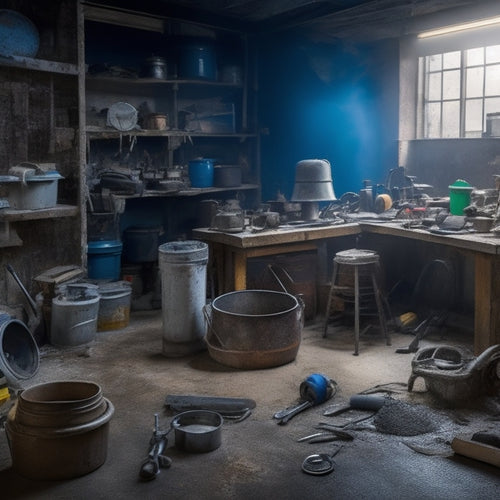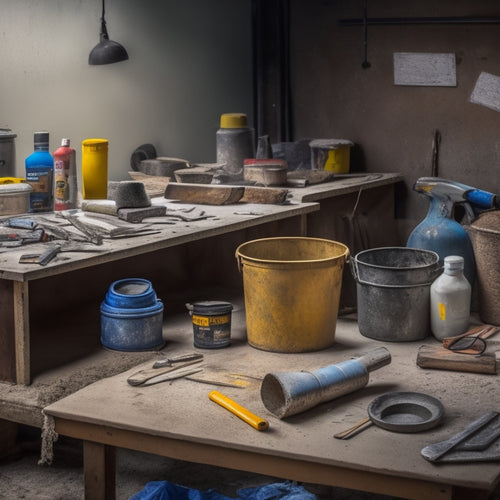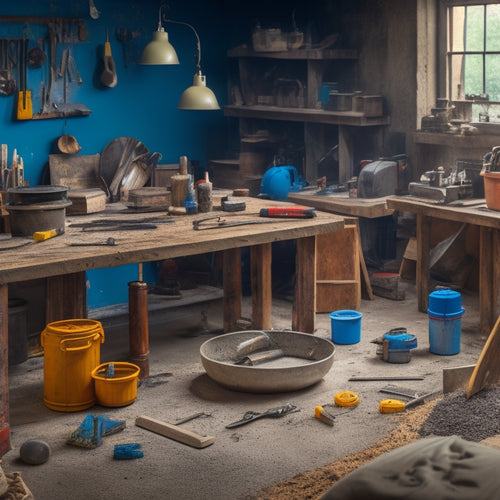
Must-Have Tools for Concrete Bonding Success
Share
You'll need a range of essential tools to achieve concrete bonding success. For surface preparation, you'll require wire brushes, scrubbers, and pressure washers to remove dirt, oil, and laitance. Accurate measuring tools, like digital scales and mixing sticks, are vital for bonding agent preparation. Specialized brushes, trowels, and finishing equipment will help you achieve a smooth, even finish. Don't forget personal protective equipment, such as safety goggles, respirator masks, and steel-toed boots, to safeguard against hazards. With these must-have tools, you'll be well-equipped to tackle your concrete bonding project - and understanding how to use them effectively will be key to achieving a professional-looking finish.
Key Takeaways
• Remove dirt, oil, and laitance using wire brushes, scrubbers, and pressure washers for a clean substrate.
• Select the right bonding agent application tools, such as natural or synthetic brushes, to ensure proper coverage and adhesion.
• Use accurate measuring tools, like digital scales or measuring cups, to mix bonding agents according to manufacturer's instructions.
• Invest in high-quality concrete finishing equipment, including trowels, floats, and edgers, to achieve a smooth, even finish.
• Wear essential safety and protective gear, such as safety goggles, respirator masks, and steel-toed boots, to prevent hazards and injuries.
Surface Preparation Essentials
Surface Preparation Essentials
To guarantee a strong bond between old and new concrete, you must properly prepare the surface by removing any dirt, oil, or laitance that may interfere with the bonding process. This involves employing effective surface cleaning techniques to ascertain a clean, sound substrate.
You should conduct a thorough substrate assessment to identify any cracks, unevenness, or other defects that may affect the bonding process.
Using the right tools, such as wire brushes, scrubbers, or pressure washers, you can remove dirt, oil, and laitance, and create a surface that's ready for bonding.
It's crucial to choose the right cleaning technique for your specific project, taking into account the type of concrete, its age, and the level of contamination. By doing so, you'll create a strong foundation for a successful bonding process.
Bonding Agent Application Tools
Your next step in the concrete bonding process involves selecting the right tools to apply bonding agents, which are critical in guaranteeing a strong, durable bond between old and new concrete.
The right application tools can make all the difference in achieving a successful bond. You'll need a variety of brushes to apply bonding agents effectively. Natural bristle brushes are ideal for applying thicker, more viscous agents, while synthetic brushes work better with thinner agents.
You may also need specialized brushes, such as foam brushes or rollers, depending on the specific application requirements. It's crucial to choose the right brush type for the specific bonding agent you're using to guarantee proper coverage and adhesion.
In addition to the right brushes, you'll need to master various application techniques, such as applying the agent in thin, even layers or using a 'W' or 'M' pattern to guarantee complete coverage.
Mixing and Measuring Tools
When preparing bonding agents, you'll need to accurately measure and mix the required components, which is where the right mixing and measuring tools come into play.
To achieve ideal bonding performance, it's essential to guarantee measuring accuracy and precise mixing techniques. A digital scale or measuring cups with precise gradations will help you accurately measure the components, while a mixing stick or paddle will facilitate thorough blending.
Consider investing in a mixing bucket with measurement markings to simplify the process. A mixing blade or whisk attachment for your drill can be useful for larger quantities or thicker mixes.
Always follow the manufacturer's instructions for the specific bonding agent you're using, and make certain to mix in a well-ventilated area.
By mastering the art of measuring and mixing, you'll be able to achieve consistent, high-quality bonding results. Remember, precision is key, so take your time and focus on developing a systematic approach to mixing and measuring.
With practice, you'll refine your techniques and become a master of concrete bonding.
Concrete Finishing Equipment
You'll next need to focus on achieving a smooth, even finish by employing the right concrete finishing equipment, which enables you to effectively manipulate and refine the bonded surface. This is where trowel techniques come into play. A high-quality trowel, such as a fresno or pool trowel, allows you to apply the perfect amount of pressure to achieve a smooth, even finish.
You'll also need to master float finishes, which require a specialized tool to create a uniform, textured surface.
In addition to trowels and floats, other essential concrete finishing equipment includes edgers, jointers, and finishing blades. These tools enable you to create clean, defined edges and joints, as well as to refine the surface texture of the bonded concrete.
By mastering the use of these tools and techniques, you'll be able to achieve a high-quality, professional-looking finish that meets your project's specifications.
With the right concrete finishing equipment, you'll be able to take your concrete bonding projects to the next level, ensuring a strong, durable, and visually appealing result.
Safety and Protective Gear
Gear up with personal protective equipment (PPE) and safety gear to shield yourself from the hazardous materials and harsh conditions inherent in concrete bonding projects. You'll be working with chemicals, dust, and heavy materials, so it's vital to prioritize your safety above all else.
Start with safety goggles that provide impact resistance and protect your eyes from flying particles. Don't forget respirator masks, which are essential for filtering out airborne contaminants and silica dust. A good quality mask will also prevent you from inhaling hazardous fumes from adhesives, solvents, and other chemicals.
In addition to these must-haves, consider investing in steel-toed boots, gloves, and a hard hat. These will safeguard you from physical hazards like falling objects, cuts, and abrasions.
Make sure your PPE fits comfortably and is properly maintained to guarantee maximum protection. Remember, safety isn't just a precaution – it's a necessity. By gearing up with the right safety equipment, you'll be able to focus on the task at hand, confident that you're protected from the risks associated with concrete bonding projects.
Frequently Asked Questions
Can I Reuse Leftover Bonding Agent From a Previous Project?
When you're considering reusing leftover bonding agent from a previous project, think twice.
You can't guarantee the agent's potency and compatibility with new application techniques. Contamination, settlement, and degradation can occur, compromising the bond's integrity.
It's better to use fresh bonding agent to secure ideal results.
Don't risk compromising your project's success – start fresh and follow the manufacturer's guidelines for the best outcomes.
How Do I Properly Store Concrete Bonding Tools When Not in Use?
When you're not using your concrete bonding tools, proper storage is essential to maintain their effectiveness.
You'll want to focus on tool maintenance to extend their lifespan.
Invest in storage solutions like airtight containers, drying racks, and protective cases to keep your tools clean, dry, and organized.
Regularly inspect and clean your tools before storing them to prevent damage and contamination.
Are There Any Eco-Friendly Concrete Bonding Options Available?
As you navigate the concrete bonding landscape, you're likely searching for a beacon of sustainability amidst the sea of chemicals.
You're in luck! Eco-friendly options are emerging, offering a greener path forward.
Look for products made from sustainable materials, such as plant-based polymers or recycled aggregates.
These green alternatives not only reduce environmental impact but also provide comparable performance to traditional bonding agents.
You're taking an essential step towards a more environmentally conscious construction practice, and that's something to build on.
Can I Use Concrete Bonding Tools for Other Masonry Projects?
When tackling masonry projects beyond concrete bonding, you'll find that your trusty concrete bonding tools can be repurposed for alternative uses.
Their project versatility shines when applied to tasks like bricklaying, blockwork, or even tile installation.
You'll discover that these tools are designed to handle a range of bonding tasks, making them a valuable investment for any masonry project.
What Is the Average Lifespan of Concrete Bonding Tools?
You'll be surprised to know that a single concrete bonding tool can apply over 10,000 pounds of pressure in a single use.
When it comes to the average lifespan of these tools, you can expect a well-maintained tool to last around 5-7 years, with some lasting up to 10 years.
However, this lifetime expectation greatly depends on your tool maintenance routine. Regular cleaning, lubrication, and storage can considerably extend the life of your concrete bonding tools.
Conclusion
You've got the know-how to guarantee a strong, long-lasting bond between old and new concrete.
With the right tools, you're well on your way to a successful project.
Consider this: according to the American Concrete Institute, a 1% increase in bonding strength can result in a 10% increase in structural integrity.
With the must-have tools outlined above, you'll be able to achieve that critical 1% and beyond, securing a durable, high-quality finish that will stand the test of time.
Related Posts
-

7 Tools to Fix Damaged Concrete Floors
You're about to tackle that damaged concrete floor, and the right tools are essential for a successful repair. Start ...
-

3 Best Tools to Buy for Concrete Repair Online
When buying tools for concrete repair online, you'll want to research multiple retailer options to find the best prod...
-

Budget-Friendly Tools for DIY Decorative Concrete Profiling
You can achieve professional-grade decorative concrete results on a budget by investing in the right combination of e...


